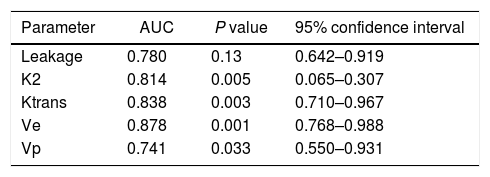Our objectives were: (1) compare dynamic susceptibility-weighted (DSC) and dynamic contrast-enhanced (DCE) permeability parameters, (2) evaluate diagnostic accuracy of DSC and DCE discriminating high- and low-grade tumors, (3) analyze relationship of permeability parameters with overall (OS) and progression-free survival (PFS) and (4) assess differences in high-grade tumors classified according to molecular biomarkers.
Materials and methods49 patients with histologically proved diffuse gliomas underwent DSC and DCE imaging. Parametric maps of cerebral blood volume (CBV), CBV-leakage corrected, volume transfer coefficient (Ktrans), fractional volume of the extravascular extracellular space (EES) (Ve), fractional blood plasma volume (Vp) and rate constant between EES and blood plasma (Kep) were calculated. High-grade gliomas were also classified according to isocitrate dehydrogenase (IDH), alpha-thalassemia/mental retardation syndrome X-linked (ATRX) and O6-methylguanine-dna-methyltransferase promoter methylation (MGMT) status.
ResultsThere is correlation between parameters leakage, Ktrans and Vp. ROC curve analysis showed significance in both Ktrans and Ve for glioma grading. Threshold value of 0.075 for Ve generated the best combination of sensitivity (80%) and specificity (75%) in tumor gradation. Leakage was the only permeability parameter related to OS (P=0.006) and PFS (0.012); with prolonged survival for leakage values lower than 1.2. IDH-mutated high-grade tumors showed lower leakage and Ktrans values. High-grade tumors with loss of ATRX presented lower leakage and Vp values.
ConclusionsBoth DSC and DCE permeability parameters serve as non-invasive method for glioma grading. Leakage was the unique permeability parameter related to survival and the best discriminating high-grade gliomas classified according to IDH and ATRX status.
1) Evaluar la utilidad de los parámetros de permeabilidad para clasificar gliomas de alto y bajo grado; 2) Analizar diferencias de permeabilidad de glioblastomas clasificados según marcadores moleculares; 3) Analizar la relación de la permeabilidad con la supervivencia global (SG) y libre de progresión (SLP), y 4) Comparar parámetros de perfusión T1 y T2*.
Material y métodosCuarenta y nueve pacientes con gliomas difusos confirmados histológicamente fueron estudiados con perfusión T1 y T2*. Calculamos los mapas paramétricos del volumen sanguíneo cerebral (CBV), CBV-leakage corregido, constante de permeabilidad (Ktrans), fracción de volumen vascular (Vp), fracción de volumen del espacio intersticial (Ve) y coeficiente de extracción (Kep). El análisis histológico se basó en criterios OMS 2007 y los glioblastomas se clasificaron según mutación de genes isocitrato deshidrogenasa (IDH), Alpha Thalassemia/Mental Retardation Syndrome X-Linked (ATRX) y metilguanidina-ADN metiltransferasa (MGMT).
ResultadosIncluimos 28 varones y 21 mujeres (16-78 años). Los gliomas se clasificaron en 41 tumores de alto grado y 8 de bajo grado. Leakage se correlacionó con SG y SLP; y mostró correlación lineal con Ktrans y Vp. Los gliomas de alto y de bajo grado mostraron diferencias en los valores de leakage, Ktrans, Vp y Ve. Leakage fue el parámetro que mejor discriminó los glioblastomas clasificados según mutación IDH y ATRX.
ConclusiónLa perfusión T1 y T2* sirven para clasificar a los gliomas difusos en función del grado tumoral. Leakage se relaciona con la SG y SLP y es el parámetro que mejor discrimina glioblastomas clasificados en función de IDH y ATRX.
Article

If it is the first time you have accessed you can obtain your credentials by contacting Elsevier Spain in suscripciones@elsevier.com or by calling our Customer Service at902 88 87 40 if you are calling from Spain or at +34 932 418 800 (from 9 to 18h., GMT + 1) if you are calling outside of Spain.
If you already have your login data, please click here .
If you have forgotten your password you can you can recover it by clicking here and selecting the option ¿I have forgotten my password¿.













